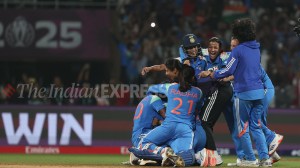Finding Wazir
Shamsur Rahman Faruqi,Urdu critic,poet and novelist,on rescuing a 19th century woman from history and on reinstating the past in the present
Shamsur Rahman Faruqi,Urdu critic,poet and novelist,on rescuing a 19th century woman from history and on reinstating the past in the present
Could the life of a woman of purdah in 19th century Delhi,bound to a largely female world of marriage and children,convey the fading grandeur of the last Mughals? Could it tell of its intrigues and warfare,or the taverns and alleys so loved of its poets?
Shamsur Rahman Faruqi,legendary Urdu critic,poet,and novelist,reclining on a bed in his daughters Delhi home,far from his Allahabad house,ponders the questions. The long day,bruised and wounded by the Delhi sun,has bled into sunset. Though evidently worn down by the heat and the festivities of a family wedding,his voice fills the room.
The 78-year-olds 2006 Urdu novel Kai Chand the Sar-e-Aasman rescued from the footnotes of history the story of a remarkable woman Wazir Khanum,known till then as the mother of the Urdu poet Daagh Dehlvi,a woman of somewhat questionable character. I found her because she was there,waiting to be found. It was not chance,I was looking for her,looking for a way to describe the richness of 18th-19th century Indo-Muslim culture. (When I found her,I realised) here is how I could do it. To me,Wazir Khanum represented its supreme essence, he says. A novel teeming with the riches of character,description and plot,which Faruqi has translated into English as The Mirror of Beauty (Penguin,Rs 699),it is anchored in the stream of Wazirs consciousness. It is also a sumptuous 1,000-page tribute to the sophisticated culture of the Mughal capital undoubtedly one of the greatest Delhi novels of all time.
In Wazir Khanum,Faruqi creates a heroine of immense power and character,who pushes at the limits set on her freedom as a woman,whose dusky beauty is described almost as a force of nature,who is at once conscious of the power of her sexuality and its price in the marketplace of human desires. The daughter of a Delhi jeweller,she is striking even as a teenager,her fame quickly overflowing the confines of her home. She is wilful and aware of her own intelligence and acumen: Show me a man to whom I could be inferior, she says. In a city where poetry is a way of life,she learns the art and craft of the ghazal from masters,and writes as Zuhrah (Venus). She rejects the paltry riches of domesticity and marriage as beneath her: I will first taste the man who wants me. I will let him stay if I like him,if not,Ill show him the door.
But the choices for self-realisation for Wazir Khanum are too few. Women of the elite classes were educated and could own property,but they could only become someones wife or mistress,or a courtesan. Wazir runs away as a teenager to live with an Englishman Marston Blake,and bears two children. When he is murdered,she returns to Delhi and becomes the lover of Shamsuddin Ahmad Khan,ruler of Lotharu and Ferozepur Jhirka. Their son,Nawab Mirza,who inherits his mothers swarthy complexion and her felicity with words,would become the poet Dagh.
Wazirs unconventional choices land her in the web of intrigue of those competing for the spoils of kingdom. She spurns the advances of William Fraser,the powerful white Mughal,and invites his wrath on her lover. Later,at the age of 34,she is wooed and becomes the wife of Emperor Bahadur Shah Zafar’s son,and enters the Haveli (the Red Fort). But like all her other alliances,this too ends in tragedy and death.
While historians dismissed her as a woman of easy virtue or a harlot,Faruqi,who is one of the foremost scholars of that period,cleared his mind of those cobwebs before he could see how unique she was. He gestures to the bed he is on,and asks,alluding to the diamond mines of Madhya Pradesh,Have you seen the workers of Panna? They have a plot smaller than this bed. They dig for years and years,20 or 30 years,till suddenly they find a gem. I was there too for most of my life,and then I found this gem.
To many,the novel that he began writing late in life (he was 66) is but one of the many gems in his long and illustrious career. The Urdu literary world treasures him more as a critic and a scholar,who,for 40 years,set the debate with his literary journal Shabkhoon. Started in 1966,it lived up to its name,which means a surprise attack by night,by consistently attacking the shibboleths of Urdu literature,its belief in the social purpose of literature and the absence of critical tools by which to evaluate poetry. From my reading of TS Eliot and other English critics,I realised that the criticism in Urdu was much wanting. They were too generalised and vague,with little analysis. They were writing in a vacuum, he says. In Shabkhoon,he clearly and openly condemned past writing,encouraged experimentation,wrote aggressive reviews,and advocated a new literary theory. He was a trendsetter in his insistence on the form of poetry,rather than its role in society. He took up the flag of modernism in Urdu literature. He argued for the idea of literature that was autonomous and not to be measured as an instrument of reform and revolution (which was the prevailing idea of the Progressive Movement), says renowned literary critic Prof Sadiq-ur-Rahman Kidwai. His band of followers would quicken to this modernist pulse,and began writing free verse,nazms,short stories and innovating the form of the ghazal. All this,he did with a full-time job as a bureaucrat in the Indian postal services.
While The Mirror of Beauty rescues the life of an ordinary woman and shapes it into fictional gold,much of Faruqis career has been spent in reinstating the past in the present. He almost seems to speak of himself when he describes the work of Wasim Jafar,a descendant of Wazir: He rejected the notion that the past is a foreign country and strangers who visit there cannot comprehend its language. He used to say that old words can be narrated in new words: all that was needed was empathy,a power and ability to embrace and to feel the warmth of the embrace.
While critics in the colonial time dismissed a whole swathe of Urdu poets,as products of a decadent culture,their poetry as marked by too much weepiness and lamenting,Faruqi did much to understand and place the great pre-modern Urdu poets Ghalib and Mir Taqi Mir in context. As his nephew,historian and author Mahmood Farooqui,puts it,he rescued the Urdu poets from Urdu critics and reintroduced us to our roots. He showed how their poetry was not simply a Romantic outpouring of somewhat effeminate souls but an exercise of control and construction,and a continuous dialogue with older poets. Nearly a quarter of a century’s work went into the four-volume exegesis on the life and works of Mir,Sher-e-Shor Angez,which earned him the Saraswati Samman. While Mir had been filed away as a poet of trite melancholy,Faruqi found a formidable range in his poetry,from the bawdy to the spiritual.
In Wazirs world,too,poetry is tangled with the business of daily life. The ghazals of the great masters are on everyones lips,cited in the teasing repartee between lovers,and in arguments that break out in the tavern. It was not an additive to life. Even Aurangzeb,who is considered to be anti-poetry,was quoting poetry all the time. It was also not the exclusive domain of the so-called people of learning. Anyone could write poetry,anyone should write poetry, says Faruqi. In the historical biographies of poets of the time,it is evident that artisans,shoemakers,traders,princes,women all wrote poetry. It was a way of existence. The best way you could make yourself understood,the best way you could understand others Because our way of life,the Hindu-Muslim way of life,placed a great value on eloquence,and the power of expression, he says.
For Faruqi,a turning point while writing this novel came when he realised that Wazir and Delhi were mirror images. It was a Delhi in decline but also in full strength. It was a teeming city,bait-ul-mamur,the Arabic phrase for a full house. Bahadur Shah Zafar was no fool,but a brilliant man,and his court was full of accomplished people. It was a literary culture,highly aware of its role in life. But it was also powerless. Like Wazir,it had everything going for it,and nothing going for it, he says.
Faruqis novel too is a baitul-mamur. George Lukacs called the novel an epic of a world abandoned by God. In The Mirror of Beauty,the Shadow of God on Earth,one of the many titles of the Mughal emperor,has all but lost his power. But the novel approximates the epic in the plenitude it encloses,the intimacy with the characters lives,from the dazzling varieties of fabrics which adorn Wazir to the types of guns available to William Frasers assassin,and the way in which the enormous richness of language imbues the lives of its characters with grace. In the pages of this novel,an entire culture becomes whole again,salvaged from the wounds of history.



- 01
- 02
- 03
- 04
- 05



























